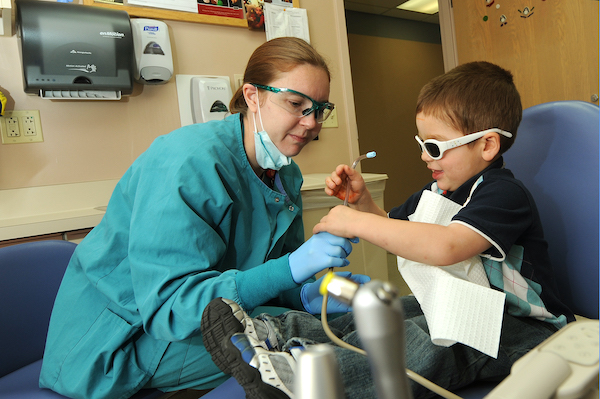 Most children in Head Start meet the requirement for having an oral exam within 90 days of beginning to attend a program. However, some children are not taken back to the dental office or clinic for needed follow-up care. A common reason parents do not seek treatment for tooth decay in primary teeth is that they are not permanent teeth.
Most children in Head Start meet the requirement for having an oral exam within 90 days of beginning to attend a program. However, some children are not taken back to the dental office or clinic for needed follow-up care. A common reason parents do not seek treatment for tooth decay in primary teeth is that they are not permanent teeth.
This Brush Up on Oral Health tip sheet discusses the importance of treating tooth decay in primary teeth and offers tips for Head Start staff to encourage parents to get follow-up care for their child.
Treating Tooth Decay in Primary Teeth Is Important
Enamel, the hard white outer surface of a tooth, is thinner on primary teeth than it is on permanent teeth. Because of this, tooth decay in primary teeth can quickly turn into a large cavity. The cavity can get so deep that it spreads to the nerve of the tooth and causes a toothache or an abscess (infection). Also, tooth decay can spread from one tooth to another. This is important, because if tooth decay is not treated, the bacteria that cause tooth decay can spread to other teeth in a child’s mouth.
When children are about age 6, their front primary teeth fall out and are replaced by permanent teeth. Around this time, a set of top and bottom permanent molars come up behind the primary molars. These permanent molars do not push primary molars out. If untreated tooth decay is in the child’s mouth, it can spread to the permanent molars and other permanent teeth as they come into the mouth.
If a child’s tooth decay is not treated, the child can have pain, trouble sleeping, behavior problems, or difficulty concentrating. Tooth decay can also lead to more serious problems that are described in the tip sheet Understanding Why Primary Teeth Are Important.
Tips for Head Start Staff to Encourage Parents to Take Children for Follow-up Oral Health Care

- Find out why the child has not been taken for follow-up care. For example, some parents may not know about the importance of primary teeth. Other possible reasons for parents not taking a child for follow-up care include cost of care, lack of transportation, dentists not accepting Medicaid for payment, cultural beliefs and practices, competing priorities, or past experiences —including parents’ own fear of dentists. Use motivational interviewing and other communication strategies to discover and discuss why parents have not taken their child for follow-up care. Help parents overcome barriers that they face in taking their child for follow-up care. The tip sheet Finding Oral Health Care offers ideas on how to help parents use oral health care.
- Share written information with parents. Support conversations about the importance of follow-up care with accurate information written in clear language that parents can understand. Healthy Habits for Happy Smiles: Understanding Why Baby Teeth Are Important describes five key roles primary teeth play in maintaining children’s health and making sure they develop appropriately.
- Host an “ask a dentist or dental hygienist” event. Invite a dentist or dental hygienist to participate in a parent event to talk about why follow-up care is important. Ask the provider to talk about how oral health care has changed and to explain that some treatment can now be done without shots or drills. Encourage parents to write questions ahead of time and ask them.
- Arrange a field trip to a dental office or clinic. Invite parents to visit a dental office or clinic where they can see how children get oral health care. Parents may have had bad experiences when they were young and do not want their children to have the same thing happen to them. Being able to see other children receiving care may help parents overcome fears.
- Establish peer-led groups to address follow-up care issues. Peer-led parenting and/or family engagement groups can be effective in helping parents overcome obstacles and achieve results. Family Connections to Peers and Community offers a summary of strategies to create social networks that support and enhance well-being and community life.
Download a PDF version to print and share.
Read more:
Resource Type: Article
National Centers: Health, Behavioral Health, and Safety
Audience: Teachers and Caregivers
Series: Brush Up on Oral Health (BUOH)
Last Updated: April 25, 2023
